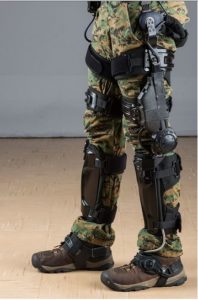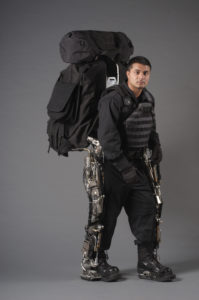Soft robotics and exoskeletons offer human-centric solutions.

On March 19, 2018, the New York Times ran a headline that said, “Self-Driving Uber Car Kills Pedestrian in Arizona, Where Robots Roam.” Although the science of robotics has made impressive strides, robots are having something of a crisis of identity. For more than a century science fiction has depicted them as either benign and humorous or evil and threatening—think R2-D2 or The Terminator.
There are public concerns about the safety of self-driving cars, privacy issues concerning drones, and uncertainty plagues how industrial robots could affect jobs for humans. In his keynote address at the Smartgeometry2018 conference, Rafaello d’Andrea, co-founder of Amazon Robotics, said, “The bottleneck to adoption [of robotics] is robustness and reliability.”
Historically, images of lunar robots struggling to negotiate extra-terrestrial terrain have done so little to excite the public imagination that when NASA cancelled its Resource Prospector robot program in May it barely received a mention in the mainstream media. The following week, NASA announced an Industry Day to discuss the Draft Request for Proposals (DRFP) for Commercial Lunar Payload Services in its stead.
This follows a second point made by d’Andrea in his talk, that robots are excellent at certain tasks, such as carrying heavy loads, but humans are much better at picking things up and using fine motor skills. We are now seeing a general shift in thinking about robots that are more human-centered in terms of their purpose and design, and soft robotics and the exoskeleton—from military uses, to workplace applications, to medical rehabilitation—are leading the way.
Doing the heavy lifting

Load bearing and movement are two key functions in the development of exoskeletons currently. Defense Advanced Research Project Agency (DARPA) has funded the Berkeley Lower Extremity Exoskeleton (BLEEX) at U.C. Berkeley’s Human Engineering and Robotics Laboratory. The laboratory has now shown the first experimental exoskeleton in which the human ‘pilot’ can carry a heavy payload while experiencing the weight of a few pounds. The motivation behind the development is to enhance (rather than replace) the performance of the human.
Strength and endurance are central, but durability, robustness, maneuvrability and ergonomics are critical factors in achieving this. Lockheed Martin and Berkeley Bionics have developed an exoskeleton that helps performance by reducing the pilot’s oxygen consumption that can lead to premature fatigue. The Human Universal Load Carrier (HULC) is a third-generation exoskeleton that provides strength augmentation by taking up to two hundred pounds of payload without impacting the wearer’s performance, while also augmenting their endurance by decreasing the pilot’s metabolic cost.
In his book Behemoth: a History of the Factory and The Making of The Modern World (2018), Joshua Freeman tells how the industry that had the greatest influence on Henry Ford was “meatpacking, where the disassembly of animals was done by hanging newly killed carcasses on an overhead conveyor, moving them from worker to worker”. Though the automotive assembly line has evolved considerably in the Ford factory of today, repetitive overhead tasks still take their toll. Some Ford factory workers lift their arms an average of 4,600 times a day—almost one million times a year with the attendant risk of fatigue and workplace injury.
Designed for the factory workplace, The EksoVest is a partnership between Ekso Bionics and Ford. The upper-body works to be minimally intrusive on the worker’s movements and can be used with common automotive work tools, such as drill and impact drivers and paint sprayers, as well as activities without tools, such as lifting underbody components into place. The exoskeleton works to elevate and support the arms, which has seen health and safety improved, as well as productivity and worker wellbeing.
Digital added value

Artificial Intelligence (AI) and sensors are bringing ‘smartness’ to exoskeleton and robot developments. Lockheed Martin and the U.S. Army are developing ONYX, a powered exoskeleton designed to relieve the stress on the wearer’s knees. An AI algorithm takes data from sensors to gain a better understanding of how the leg moves and applies a power boost to the mechanical actuators. Flexible and lightweight, it’s ideal for military infantry or first responders traversing step inclines or mountainous terrain.
The Berkeley Robotics and Human Engineering Laboratory are developing an IAD sensory glove designed for each individual human operator. The Magic Gloves measure the force the wearer imposes on the object being handled. The instrumented glove generates signals on contact with the object. This allows the device actuator to provide the additional support needed, so that the human operator need exert a relatively small amount of effort in realizing the task.
In medical and sports rehabilitation, digital stimulus is helping to achieve a more focused treatment and faster patient recovery. Ekso Bionics is combining their EksoGT medical exoskeleton with RehabStim2 that provides Functional Electrical Stimulation (FES). FES brings low-energy electrical impulses to targeted muscles to enhance movement and gait training during the rehabilitation process.
The electrical pulses work by artificially generating body movements in patients whose central nervous systems have been damaged, resulting in paralysis. While this form of electrical stimulation is not new, incorporating it into an exoskeleton to aid rehabilitation is. For the patient, it allows for more independent movement and a more finely tuned recovery program.
Touch sensing
Researchers at Stanford University and Seoul National University have developed an artificial nerve sensory system. The touch sensor can detect very small forces, sending signals through a flexible electronic neuron to an artificial synaptic transistor that is modelled on the human synapses that can relay signals, store information and make simple decisions.
Professor Zhenan Bao of Stanford University says, “We take skin for granted, but it’s a complex sensing signalling and decision-making system … this artificial sensory nerve system is a step toward making skin-like sensory neural networks for all sorts of applications.”
Tae-Woo Lee, a researcher on the project from Seoul National University, gives knee reflex as a potential use, where an advanced artificial nerve circuit might form part of a synthetic skin that would give prosthetic devices and robots both senses and reflexes.
Human participation required
The National Transportation Board’s preliminary report issued on May 24, 2018, on the Arizona pedestrian fatality found that the self-driving system identified the victim as “an unknown object, as a vehicle, and then as a bicycle with varying expectations of future travel path.” Crucially, according to Uber, while the vehicle is under computer control, the human vehicle operator must intervene to operate emergency brakes.
In Australia, Dr. George Quezada of the Commonwealth Scientific and Industrial Research Organisation (CSIRO) sees an aging population requiring greater use of robots and “digital collaboration platforms” over the next twenty years, particularly for physically demanding industries such as construction. He sees careful strategic thinking as essential if we are to successfully navigate these waters.
“The changes will require humans to exercise judgment and decision-making that reflects human values and aspirations; a task that is well beyond the most advanced artificial intelligence system,” Quezada says.
Marie O’Mahony is an industry consultant, author and academic. She the author of several books on advanced and smart textiles published by Thames and Hudson and Visiting Professor at the Royal College of Art (RCA), London.
 TEXTILES.ORG
TEXTILES.ORG


